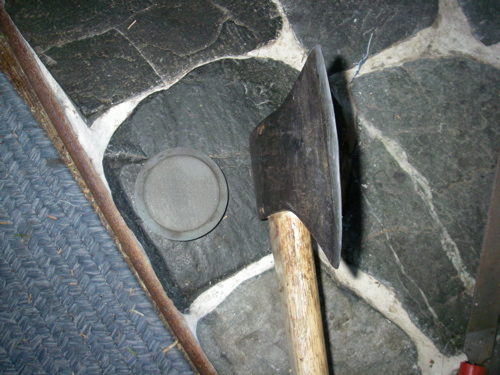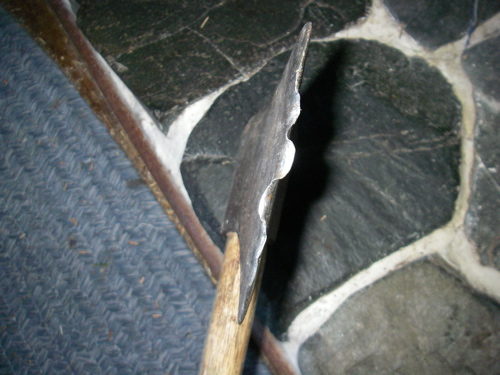I often damage my felling or limbing ax, warping the thin-blade against knots or harder sections of wood. When this happens, I have to repair the blade to make it cut well once again. Here’s how I do it.
If it’s cold outside, I make sure to bring the ax into the house for a while before working on it. I don’t want to do the following with a blade made brittle by the cold.
Along with the blade needing repair, I gather a sledge hammer, a ball peen hammer, a metal file, a “puck” whetstone, and honing oil. I find make a comfortable place on the floor, lay out some newspaper, and begin:
Using the sledge hammer head as an anvil, I lay the warped blade on the sledge face, and beat the blade straight with the ball peen hammer. I do all of the blade work as symmetrically as I can, turning the blade over often to work on both sides. I beat the warps out of the blade, making it as true as possible.
Next, I take the file and shape the blade. I file in one direction only, so as not to damage the file. I try to make long, continuous passes in an arc, following the curve of the blade edge. I make a few passes, turn the blade over, and make another few passes, alternating sides. I repeat until the edge is a smooth arc.
I work slowly so as not to build up too much friction heat. This is why I don’t just use a grind stone—friction can “burn” the blade. Since I don’t know how much heat that takes, I’m careful to avoid letting it warm up noticeably.
Sprinkling the coarse side of the puck with a few drops of honing oil, I work along each side of the blade in a circular motion, reshaping the new edge until it’s sharp. When I’m satisfied, I oil the medium side of the puck, and finish the new blade. I try not to bear down on the stone, especially toward the end, letting the weight of it provide the pressure.

Problem Solved: the reshaped, resharpened blade is good to go. “Puck” whetstone at left. (Photo: Mark Zeiger).
When I’m done, I give the blade a thin coat of gun oil, and it’s ready to go back to work.



The ax has problems beyond simply a warped edge. It needs to be thicker if you are using it on knotty wood. You have also introduced lots of stress into the steel by hammering the edge straight again. The edge is no longer strong, even though you have “fixed” it. My suggestion is to make/buy a thicker felling ax or use a heaver splitting ax. Its more work but your tools will last longer. If you know a local blacksmith, have them re-tempter the blade and/or forge-weld a piece of 5160 onto the edge and taper it out to shape.
Good Luck,
Eugene
Eugene, you’re right on all points. In other posts I differentiate between this ax, which I use exclusively for felling, and my splitting ax, the same product from the same manufacturer, chosen for splitting because its blade was thicker off the rack.
The repaired blade will never be as strong as it was before without a blacksmith’s help. Nevertheless, I’ve used this particular blade for limbing over the last three years. It does its job well, and has not been damaged any further. It’s good enough to see me through for a while yet without additional expense.